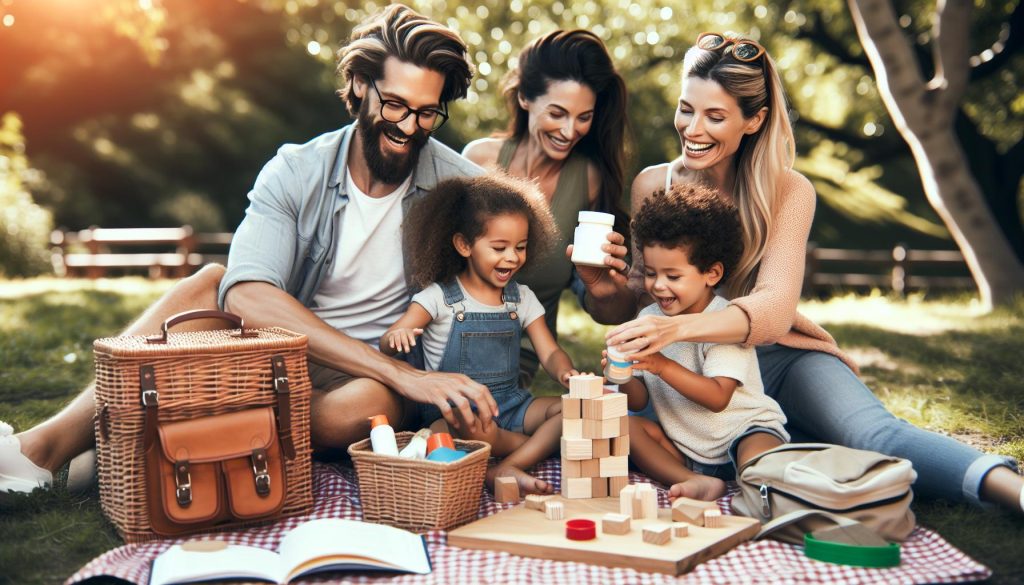Arnica Cream for Kids: Soothing Relief for Bumps and Bruises
Are your little ones prone too turning everyday adventures into a slapstick comedy of bumps and bruises? Fear not! Enter the superhero of the first aid kit: Arnica cream! This magical, herbal powerhouse doesn’t just soothe those certain falls and tumbles; it transforms the “ouch!” into a delightful “Ahh!” With a hint of nature’s best ingredients, it offers gentle relief without the fuss, keeping kids smiling in the face of minor mishaps. so, buckle up as we dive into the world of Arnica cream for kids—where healing meets hilarity, and every scrape becomes a chance for a giggle!
Understanding Arnica: The Natural Remedy for Kids’ Injuries
Arnica montana, commonly known as arnica, is a flowering plant that has been used for centuries as a natural remedy for bruises, bumps, and muscle pain.This herb is a go-to solution for many parents seeking gentle, effective treatments for their children’s minor injuries. When applied topically as a cream or gel, arnica offers a soothing sensation that can help alleviate pain and promote healing.
What makes arnica particularly appealing for kids is its natural composition, which helps reduce inflammation and swelling. It is significant to note that arnica should only be used externally and is not suitable for open wounds.Parents can find arnica creams in pharmacies and health stores, frequently enough labeled specifically for children, ensuring safety and effectiveness.
here are some key benefits of using arnica for your little ones:
- Natural anti-Inflammatory: Reduces swelling and bruising.
- Pain Relief: Offers local pain relief when applied directly to sore areas.
- Quick Absorption: Creams are quickly absorbed into the skin, delivering relief faster.
- kid-Amiable: Made for kids, arnica creams are typically free from harsh chemicals.
| Usage | Recommended Age | Request Frequency |
|---|---|---|
| Minor Bruises | 2 years and up | As needed, up to 3 times a day |
| Muscle Strains | 3 years and up | Every 4-6 hours, for up to one week |
How Arnica Cream Works: mechanisms Behind Pain Relief and Bruising
Arnica cream has gained attention for its ability to alleviate pain and reduce bruising, particularly in children who are prone to bumps and falls. The key to its effectiveness lies in its active compounds, primarily helanolide and arnicins, which contribute to its anti-inflammatory and analgesic properties.When applied to the skin, these compounds stimulate the body’s natural healing processes, which can significantly help in minimizing discomfort.
The mechanisms behind arnica’s action are multifaceted:
- Anti-inflammatory response: Arnica triggers the production of anti-inflammatory cytokines that help combat swelling and inflammation around minor injuries.
- Pain relief: the cream interacts with local nerve receptors, blocking pain signals and providing a soothing effect.
- Improved circulation: By enhancing blood flow to the affected area, arnica facilitates faster recovery and healing of bruises.
Research supports these claims, showcasing that children treated with arnica cream experienced a notable reduction in pain and swelling. A study indicated that arnica was as effective as traditional pain relievers in addressing discomfort from minor injuries, making it a safe and natural alternative for young patients.
for parents considering arnica cream, it’s helpful to understand its application:
| Application Tips | Frequency |
|---|---|
| Apply a small amount to the affected area | 2-3 times daily, as needed |
| Gently massage into the skin | Until fully absorbed |
| Avoid broken skin or open wounds | N/A |
By understanding how arnica cream functions, parents can feel more confident in using it to provide soothing relief for their children’s inevitable bumps and bruises.
Safety First: Using Arnica Cream for Children
When it comes to applying arnica cream on children, safety is paramount. Arnica, derived from the flower of the *Arnica montana*, is known for its natural anti-inflammatory and analgesic properties. However, it’s essential to consider a few key points before introducing it into your child’s routine.
- Use Age-Appropriate Formulations: Always select formulations specifically designed for young skin. Many brands offer arnica creams that are safe for children aged two years and up,but it’s crucial to read labels carefully.
- Perform a Patch Test: before applying arnica cream, a patch test on a small area of your child’s skin should be performed to check for any allergic reactions. This is particularly critically important for children with sensitive skin.
- Avoid Open Wounds: Never apply arnica cream to broken skin or open wounds. While it can help with minor bruises and bumps, applying it to cuts or scrapes can cause irritation.
- Consult a Pediatrician: For children with pre-existing skin conditions or those who are pregnant or breastfeeding,consult a healthcare provider to ensure the safe use of arnica.
The typical application involves gently massaging a small amount of the cream onto the affected area,which can significantly help reduce swelling and alleviate pain. However, dosages and frequency should also be monitored—generally, applying the cream two to three times a day is sufficient. Always ensure to wash hands after application to prevent accidental ingestion or contact with eyes.
| Application Tips | Notes |
|---|---|
| Apply to bruises and swelling | Use sparingly and massage gently |
| Keep out of reach of children | Store in a cool, dry place |
| Monitor for reactions | Discontinue use and consult a doctor if irritation occurs |
By following these guidelines, arnica cream can be a soothing addition to your child’s first-aid arsenal, providing relief from the common bumps and bruises of childhood while ensuring that safety always comes first.
Application Tips: How to Effectively Use Arnica Cream on Kids
When applying arnica cream on children, it’s critically important to follow a few simple guidelines to ensure safety and effectiveness. Here are some essential tips to make the most of this natural remedy:
- Patch Test First: Before using arnica cream, conduct a patch test on a small area of skin to check for any allergic reactions. Apply a small amount and wait for 24 hours to monitor for redness or irritation.
- Clean the Area: Gently clean the affected area with mild soap and water, ensuring it’s free from dirt or debris. This helps the cream absorb better and maximizes its soothing effects.
- Apply Sparingly: Use a small amount of arnica cream and apply it as a thin layer over the bruise or bump. Massage it gently into the skin to promote absorption, but avoid excessive pressure as this may cause discomfort.
- Frequency of Application: Apply the cream two to three times a day, or as directed by a pediatrician. Consistency is key to achieving the desired results in reducing bruising and swelling.
- Monitor for Sensitivity: Keep an eye on how your child reacts after application. If any signs of irritation occur, discontinue use immediately and consult a healthcare professional.
Arnica cream should be strictly applied to external surfaces and should never be used on broken skin or open wounds. Moreover, it’s essential to avoid contact with the eyes or mucous membranes.For young children, guiding them through the application process can make it a fun and bonding activity. Allow them to feel empowered by letting them help apply the cream themselves, fostering a positive association with the remedy.
To further enhance the application process, consider the following:
| Time of Day | Recommended Activity | note |
|---|---|---|
| Morning | Post-bath application | Soothes after a busy night |
| Afternoon | Before playtime | Prevents discomfort during active play |
| Evening | Pre-bedtime routine | Promotes healing overnight |
By incorporating these practices, you can ensure your child receives the maximum benefits of arnica cream while making the experience enjoyable and stress-free. Always keep an open line of dialog with your child to reassure them and explain the purpose of the treatment, making it a positive part of their recovery process.
Assessing Efficacy: What Research says About Arnica for Bruises and Bumps
When it comes to the effectiveness of arnica for treating bumps and bruises in children, research has yielded promising, albeit mixed, results. Several studies indicate that arnica, particularly arnica montana, may aid in reducing swelling and pain associated with minor injuries. As a notable example, a randomized controlled trial published in a dermatological journal found that participants who applied arnica gel showed significantly less discoloration and tenderness compared to those who received a placebo treatment.
Moreover, its anti-inflammatory properties can play a key role in healing. The active compounds in arnica, such as helenalin, are believed to work by inhibiting inflammatory pathways in the body. This can help improve blood circulation to the affected area, perhaps accelerating the healing process.
Though, while many parents swear by arnica for their little ones, it’s essential to consider individual responses. Some children may experience a reduction in pain and an improved appearance of bruises, while others might not see much difference at all. Here are a few important points to keep in mind:
- usage Method: Topical application is generally safe, but it should never be applied to open wounds or broken skin.
- Dosage: Follow the manufacturer’s guidelines for quantity and frequency of use to ensure safe administration.
- Consultation: Always consult with a healthcare provider before using arnica, especially for young children or if your child has allergies.
while arnica may offer a soothing solution for bumps and bruises, the degree of efficacy can vary widely. Parents looking for natural remedies should weigh the evidence and consider their child’s unique needs and medical history.
Alternatives and Complements: Other Soothing Remedies for Childhood Injuries
In addition to arnica cream, there are several other remedies that parents can consider to soothe their kids’ bumps and bruises. Natural treatments often offer comforting relief without the concerns associated with harsh chemicals or medications. here are a few options worth exploring:
- Cold Compress: Applying a cold compress or ice pack wrapped in a cloth can help reduce swelling and numb the pain. This method is effective in the first 24 hours after an injury.
- Calendula Cream: Known for its anti-inflammatory properties, calendula can be an excellent healing agent for minor cuts and bruises, promoting skin regeneration.
- Honey: A natural antiseptic, honey can be applied to wounds to promote healing and prevent infection, thanks to its soothing properties.
- Vitamin E Oil: Applying vitamin E oil can help fade bruising,promoting healing and reducing scarring on the skin.
Another effective approach includes herbal teas made from chamomile or ginger. These can be given to children (in diluted forms for younger kids) for their anti-inflammatory properties. Chamomile, in particular, is recognized for its calming effects that may ease anxiety post-injury. Additionally, herbs like comfrey and plantain can be used topically as poultices to alleviate pain and speed up recovery.
| remedy | Benefits |
|---|---|
| cold Compress | Reduces swelling,numbs pain |
| Calendula Cream | anti-inflammatory,promotes healing |
| Honey | Antiseptic,promotes wound healing |
| Vitamin E Oil | Fades bruising,reduces scarring |
These alternatives,when used alone or in combination with arnica cream,can provide soothing relief for your little ones. Always remember to consult with a pediatrician before trying new treatments to ensure safety and suitability for your child’s specific needs.
When to Seek Medical Advice: Recognizing Serious Injuries in Kids
as parents, recognizing when a child’s injury requires medical attention is crucial. while bumps and bruises are common in active kids, certain signs may indicate a more serious condition. Always err on the side of caution, and consider seeking medical advice if you notice any of the following:
- Persistent Pain: If your child is experiencing severe pain that doesn’t improve with rest or over-the-counter pain relievers, a healthcare professional should evaluate the injury.
- Swelling or Bruising: Extensive swelling or significant bruising,especially around a joint,may indicate a fracture or other serious injury.
- Inability to Move: If your child can’t move the affected area or is limping, it’s a strong signal that medical examination is needed.
- Visible Deformity: Any noticeable deformity in a limb or joint should be assessed by a specialist to determine the extent of the injury.
- Signs of Infection: Redness, warmth, or pus at the injury site, accompanied by fever, may suggest an infection requiring prompt treatment.
- Head Injuries: If your child suffers a head injury and exhibits confusion, vomiting, or balance issues, seeking emergency care is essential.
obtaining timely medical assistance can prevent complications and ensure proper care for your child. Always keep an open line of communication with your pediatrician and don’t hesitate to ask for help when in doubt.
Faq
What is Arnica Cream, and how does it work for bruises and bumps in kids?
Arnica cream is a topical preparation derived from the Arnica montana plant, which is commonly found in Europe and North America. Traditionally, it has been used for centuries to help alleviate pain associated with sports injuries, bumps, bruises, and muscle soreness. The active compounds in arnica, primarily helenalin and other sesquiterpene lactones, are believed to possess anti-inflammatory and analgesic (pain-relieving) properties. These compounds can help promote healing by stimulating blood flow to affected areas and reducing swelling.
When applied to the skin, arnica cream penetrates the outer layers and interacts with underlying tissues. This interaction helps to reduce localized inflammation, thereby minimizing discomfort and bruising. Studies indicate that arnica might potentially be effective in reducing pain associated with minor trauma. Such as, a study published in the Journal of Clinical Rheumatology illustrated that patients using arnica experienced significant pain relief compared to those using a placebo. This makes it a popular choice among parents looking for natural methods to soothe their children’s complaints after a tumble or a fall.
Is Arnica Cream safe for children?
Arnica cream is generally considered safe for children when used topically and in accordance with product instructions. However, it is crucial to ensure that the formulation is specifically designed for children’s sensitive skin, as some over-the-counter arnica creams contain additional ingredients that may not be suitable for all age groups. Dermatologists often recommend starting with a patch test,applying a small amount of the cream to a discreet area to monitor for any adverse reactions.
It’s also important to note that arnica should never be applied to open wounds, broken skin, or mucous membranes; doing so may cause irritation or further complications. Parents should always supervise young children during application to prevent ingestion, as ingesting arnica can lead to more severe complications such as gastrointestinal issues or heart problems. Consulting with a pediatrician is also advisable if there are any concerns or questions about using arnica for specific situations or conditions.
How should I use Arnica Cream on my child’s bruises?
To effectively use arnica cream on your child’s bruises, follow these simple steps:
- Clean the Area: Gently wash the bruise area with mild soap and water to remove dirt and impurities. Pat the skin dry with a clean towel.
- Apply Sparingly: Squeeze a small amount of arnica cream onto your fingertip or a cotton swab. Apply a thin layer to the affected area and gently massage it into the skin. It is best to do this 2-3 times daily, or as directed by the product label or a healthcare professional.
- Monitor for Reactions: After using the cream, keep an eye on the bruised area for any signs of irritation or allergic reaction, such as redness, itching, or stinging.
Parents frequently enough find it helpful to explain to their children what the cream does and why it is indeed beneficial. Creating a positive experience around the application can definitely help children feel more comfortable and even make it a fun routine to follow after minor spills or scrapes. It typically takes a few days to notice improvement, but most parents report that their kids experience relief more quickly.
Can Arnica Cream help with pain beyond bruises?
Yes, arnica cream can assist in alleviating various types of minor pain beyond just bruises. Many parents use it effectively for muscle soreness,joint pain,sprains,and even insect bites. Its anti-inflammatory properties allow it to work well for swelling and discomfort related to physical activity,making it a go-to for kids involved in sports or outdoor play.
For instance, when a child participates in activities like soccer or cycling, they may experience muscle aches or soreness afterward. Applying arnica cream can help soothe those muscles and speed up recovery. In a study conducted on athletes, those who used arnica cream post-workout reported a noticeable decrease in muscle soreness and recovery time compared to those who did not use any treatment. This versatility makes arnica cream a valuable addition to a family’s first aid kit because it can address a range of minor injuries and discomforts.
Are there any side effects associated with using Arnica Cream?
Most children tolerate arnica cream well, but like any topical treatment, there can be minor side effects. The most common reactions include localized skin irritation, such as redness, itching, or a burning sensation. This is usually mild and can be alleviated by discontinuing use and washing the area with water. Choosing formulations without harsh additives or fragrances can help reduce the likelihood of such reactions.
In rare cases, some individuals may experience allergic reactions to arnica, especially if they have a history of allergies to plants in the Asteraceae family, which includes daisies and marigolds. Symptoms of an allergic reaction could range from more significant redness and swelling at the site to systemic symptoms like difficulty breathing, which would require immediate medical attention. Therefore, it is prudent to monitor your child for both common and rare side effects after applying arnica cream, especially during the first few uses.
Can I use Arnica Cream alongside other treatments?
Using arnica cream in conjunction with other topical treatments can be beneficial; however, it’s essential to approach this carefully.It’s generally best to avoid applying arnica concurrently with other creams or ointments unless directed by a healthcare professional, as this can alter how well each product works and potentially lead to skin irritation.For example, some parents may be tempted to mix arnica with hydrocortisone cream for joint pain, but these combinations should be treated with caution.
When considering other treatments, also take into account the specific needs of your child’s condition. It can be helpful to consult with a pediatrician to create an appropriate treatment plan. In many cases, arnica cream can supplement care strategies, including rest, ice, and elevation for sprains and strains, ensuring a more comprehensive approach to managing minor injuries. This holistic application is often recommended for the best outcomes after injuries or during recovery from physical activity.
Wrapping Up
arnica cream stands out as a reliable and soothing option for parents seeking to alleviate the discomfort of their children’s bumps and bruises.With its natural anti-inflammatory properties and a rich history of use in both traditional and modern medicine, arnica offers a safe alternative to conventional treatments, making it a favorite among caregivers. Research,including studies published in reputable medical journals,supports its efficacy in promoting healing and reducing pain. However, as with any topical treatment, it’s essential to use arnica cream appropriately and consult with a healthcare professional to ensure it’s suitable for your child’s specific needs. By incorporating arnica into your first-aid toolkit, you can empower yourself to provide effective and nurturing care, helping your little ones recover swiftly from their inevitable childhood scrapes and falls. Stay informed,stay prepared,and rest assured that with the right knowledge and tools,you can offer your kids the comfort they need during their active play.




